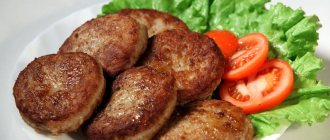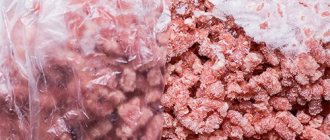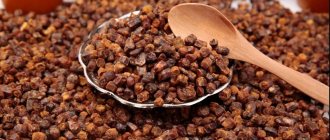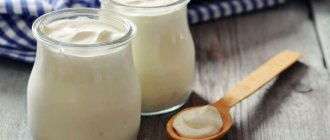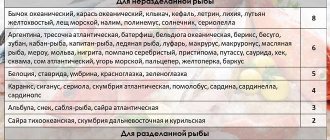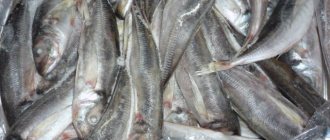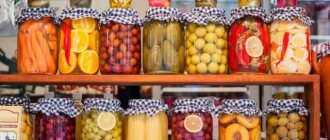How to prepare meat, poultry or fish for freezing
How to properly prepare food for freezing:
- It is recommended not to wash the meat: water accelerates the decomposition processes in the tissues.
- It is better to divide the product into small pieces, since large pieces are more susceptible to spoilage.
- Soft tissue should be separated from the bone.
It is recommended to wrap it in a napkin soaked in vinegar.
The fish should be gutted, washed and removed excess moisture
It is not recommended to defrost meat in water (cold or hot); it is better if it thaws gradually in the refrigerator.
You cannot store it in the refrigerator on a wooden cutting board, which will quickly absorb the juice: the taste and nutritional qualities are lost.
The fish should be gutted, washed and excess moisture removed. We also recommend reading how to properly defrost fish.
SanPiN 2.3.2.1078-01
Sanitary rules include hygienic requirements for the safety of food products, including meat and fish.
According to SanPiN 2.3.2.1078-01, animal meat, poultry and fish must:
- provide the human body with the substances necessary for its normal functioning;
- have the usual taste and smell.
The document reflects the maximum content of chemical pollutants and biological organisms that can harm human health.
In fresh, chilled and frozen meat, semi-finished products, the amount of toxic substances should not exceed, in mg/kg:
- lead – 0.5;
- arsenic – 0.1;
- cadmium – 0.05;
- mercury – 0.03.
According to the rules, parasitological control of meat and fish products is mandatory.
How much and how to store: raw, frozen, chilled, fried, smoked, salted
Preparing meat and poultry in chilled form is recognized as the most perfect method , stopping the processes of decomposition and rotting, but allowing to save most of the vitamins and nutrients.
Preparing meat and poultry in chilled form is recognized as the most advanced method
The use of new technologies when packaging perishable meat and fish products makes it possible to extend their shelf life:
- The product is placed in a sealed package , a vacuum is created artificially - the air containing a huge number of microorganisms is completely pumped out. Vacuum sealing significantly increases the shelf life.
- They are washed, excess moisture is removed, coated with special components and placed in trays. The injection of a gas mixture of oxygen and carbon monoxide is carried out after pumping out the air. The gas ratio varies depending on the form in which the carcass is packaged: whole or cut into pieces.
- They are placed in a polymer film, then sterilized by heating to a certain temperature. This method has gained popularity as it prevents the development of bacteria that cause decomposition and spoilage. It allows you to preserve the taste of products.
Read more ► How to salt fish for drying at home: how to make dried fish, differences, best methods
The shelf life of refrigerated meat depends on its type. For example, pork is stored for 5-8 days, poultry – 10-12 days.
Beef
Beef spoils quickly at room temperature.
The length of beef storage depends on the temperature and other conditions:
- 12 months – at -18 °C or less, relative air humidity 95-98;
- 48 hours – frozen, at +8 °C;
- No more than a week – chilled, up to + 4 °C.
Beef spoils quickly at room temperature.
Pork
It is not recommended to immediately cook meat after slaughtering an animal. Pork becomes good after a few days in a cool place.
At a relative humidity of 95-98%, pork can be stored in months:
- at -18 °C in skin, – 8;
- at -18 °C without skin – 6;
- at -25 °C and below – 12-14.
From 0 to +6 °C, packaged pork has a freshness of 36 hours.
Mutton
Lamb is a perishable product, therefore it is preserved under appropriate conditions, in 24 hours:
- chilled, in a suspended state (-1 0С, 85% humidity) – 12;
- frozen, in a stack or hanging (-2 0C, 90% humidity) – 20.
Frozen mutton or lamb at a humidity of 95% and temperature is subject to preservation, in months:
- down to -12 0C – 6;
- -18 0С – 10;
- -20 0С – 11;
- -25 0С – 12.
Changing the temperature significantly reduces shelf life.
Chicken and other poultry
During long-term storage, poultry loses its nutritional value.
Maximum period for preserving poultry in a freezer at -15 °C and below, in days:
- chickens – 7;
- turkey meat – 10.
At temperatures below -25 °C, the shelf life increases to 12 and 14 months, respectively.
Chilled poultry is suitable for consumption at temperatures from 0 to +4 °C - no more than 5 days, at +8 °C - 24 hours.
During long-term storage, poultry loses its nutritional value, this is especially true for ducks and geese, whose fat acquires a rancid taste.
Sausage, frankfurters, ham and lard
Smoked and boiled sausages contain up to +8 °C for a period of time, in hours:
- boiled sausage, ham, boiled pork – 72;
- sausages, sausages, liver and blood sausage – 48.
Boiled-smoked and half-smoked sausage is stored under similar conditions for 10 days, and at +8...+20 °C - 72 hours. Semi- and raw smoked sausages in a vacuum do not spoil at +20 °C for 4 days.
Lack of packaging integrity immediately changes the conditions and terms of preservation.
The shelf life of ham is also determined by the degree of heat treatment and corresponds, in days:
- boiled whole – 5-7, cut – no more than 3;
- smoked-baked – 5-8;
- boiled and raw smoked – up to 45;
- dry-cured – 180.
Read more ► Methods for storing live and boiled crayfish, how to properly freeze for a long time
Fresh lard is kept at +10 0C and below. When frozen, it preserves its taste and nutritional properties for about a year. It is good to store salty in three-liter jars or wrapped in paper.
Fresh lard is kept at +10 0C and below
It is intended for long-term storage in cool conditions. Suitable packaging for hot smoked lard is paper or foil.
Fish
Fish is a perishable product. When fresh, it is stored at -2...0 °C. At higher temperatures, containers with ice cubes are suitable.
It is prohibited to store fresh fish indoors; it must be immediately processed in any form. Fried fish is kept at temperatures up to +2 °C for no more than 48 hours.
Before freezing, the fish is never skinned, which prevents it from drying out. In a chamber maintained below -20 °C, the product is preserved for 3-6 months.
Depending on the degree of processing, salted fish is stored in vacuum packaging, in days:
- lightly salted – 6-7;
- medium salted – 10-12;
- highly salted – up to 30.
In the refrigerator, salted salmon in a regular bag is suitable for consumption for no more than 3 days.
Smoked fish, depending on the cooking method and in sealed packaging, is suitable for:
- hot smoked – 3 days;
- cold – 10 days.
Minced meat and fish
Only freshly prepared minced meat is frozen ; it is kept in compressed form for no more than 3 months. Repeated freezing leads to the destruction of beneficial qualities.
Only freshly prepared minced meat is frozen
Minced meat belongs to the group of perishable products; at +8 °C it remains fresh for 6 hours.
Mixing minced meat from different types of meat and adding spices speeds up the spoilage of the product , so these manipulations are done immediately before preparing cutlets or other products.
Storage period for products made from minced pork and semi-finished products made on its basis, in hours:
- portioned (beefsteak, langet) – up to 36;
- minced meat, stuffed cabbage rolls, pepper – 6.
Minced fish cutlets stored in the refrigerator must be cooked within 12 hours.
By-products
Suitability of frozen offal transferred from the freezer to chambers with higher temperatures, in hours:
- 0 °C – 72;
- from 0 to 6 °C – 48;
- +8 °C – 24.
Chilled by-products are stored in hours:
- from 0 to +6 °C – 36;
- +8 °С – no more than 12.
Frozen offal retains its nutritional value for 4 months.
Types of semi-finished meat products
On the shelves of meat departments in stores you can always see beautifully packaged meat products. A huge range of products often leaves the buyer confused , and for a long time he cannot decide what to choose.
It will be easier to make purchases if you know the differences between semi-finished products. Groups of such products are distinguished according to the following criteria :
- type of meat used (beef, pork, lamb, poultry);
- processing method (natural meat, minced meat, products in dough and special purposes);
- thermal state (chilled or frozen).
It can be useful:
How to eliminate unpleasant odors in the freezer
How to get rid of mold smell in the refrigerator
Why you shouldn't put hot food in the refrigerator
Natural meat comes in different shapes and sizes:
- large-piece - pieces weighing from 250 to 1000 g are cut from certain parts of the carcass;
- portioned - pieces are separated from tender muscle tissue (tenderloin, langet, entrecote);
- small-piece - small pieces are used to make goulash, frying, and shish kebab.
Minced meat is made from raw materials of animal and plant origin . They can be mixed (pork and beef). Chopped semi-finished products include cutlets, beefsteaks, rump steaks and schnitzels. They are produced with or without breading. In the first case, the products must be evenly coated with breading. When cut, the mass should be homogeneous and have a characteristic meaty smell.
Dough products consist of a shell and a filling of minced meat, which can be made from offal. Dumplings vary in the quality and composition of the minced meat used.
Important! Special-purpose semi-finished products are produced to feed children in kindergartens and schools. They have high nutritional value and guaranteed quality.
All of the above products can be sold both chilled and frozen . But there are chopped semi-finished products that are sold only frozen (quenelles and dumplings).
How to determine the freshness of meat and fish and understand that the product has gone bad?
Characteristics of fresh meat:
- Bone marrow fills the internal cavity of the bone and is easily separated from it. A white or gray tint to the bone marrow indicates a rotten product.
- Elastic structure: after pressing on the fabric, the shape is restored.
- Color. Pork is pale pink, beef or lamb is dark red. A yellowish and grayish tint indicates damage.
- Smell. Beef and lamb have a specific smell, pork has a faint smell. The meat should not taste sour or rotten.
Spoiled meat differs in appearance: it is covered with mucus and a sticky and cloudy liquid flows out of it.
Spoiled meat differs in appearance
The freshness of fish is determined by the following characteristics:
- faint odor with a taste of iodine;
- shiny, tight-fitting scales;
- lack of bloating in the abdominal area;
- transparent eyes;
- reddish gills.
Eating spoiled meat or fish is contraindicated.
Storage of large-sized semi-finished products
Before shipment from the manufacturer, chilled semi-finished products must have a temperature inside the product of no lower than 0 and no higher than 8 0C, frozen semi-finished products must have a temperature no higher than -8 0C.
The shelf life and sale of refrigerated semi-finished products from the end of the technological process is 48 hours, including 12 hours at the manufacturer.
At public catering establishments, frozen semi-finished products are stored and sold at a temperature not exceeding -5 0C for 48 hours, without exceeding the general shelf life limit.
The shelf life of large-piece semi-finished products vacuum-packed in film at a temperature of 0-4 0C is: for beef and lamb no more than 5 days, for pork no more than 3; at a temperature of 0-2 0C for beef and lamb no more than 10 days, for pork no more than 8 days.
At a storage temperature of -12 0C, the shelf life will be: for beef and horse meat - 3 months, for pork - 1.5 months, and at a temperature of -18 0C: for beef and horse meat - 6 months, for pork - 3 months.
Large-piece semi-finished products are transported in refrigerated or isothermal transport, ensuring the preservation of product quality.
Portioned and small-piece semi-finished products.
Portioned and small-piece semi-finished products are made from certain pieces of meat pulp and large-piece semi-finished products. Portioned and small-piece semi-finished products are produced in a chilled and frozen state.
Portioned semi-finished products . Portioned semi-finished products are one or two pieces of meat approximately equal in weight. They are intended for frying in whole pieces. For their production, only the most tender parts of the carcass are used - tenderloin, flesh of the back, lumbar and hip parts, which make up 14-17% of the weight of a beef or horse carcass, 29-30% of a pork or lamb carcass.
The meat of other parts of the carcass (the flesh of the hind leg, shoulder, brisket), although full in protein composition, is characterized by increased rigidity, therefore it is used for stewing or preparing minced meat. It can be used for portioned semi-finished products only after softening, which is possible with prolonged ripening of meat under the influence of enzyme preparations. Under the influence of enzyme preparations, the processes that determine the tenderness, juiciness, taste and aroma of meat are accelerated 2-3 times.
To increase the tenderness of meat, such enzyme preparations are suitable, the influence of which does not reduce the nutritional value of the meat and does not break down amino acids in it, but some structural changes in proteins occur, as during natural ripening of meat.
To artificially soften the meat of hard parts of the carcass, proteolytic enzymes of microbial, animal and plant origin can be used, which allows increasing the yield of meat from beef and horse carcasses for the production of natural semi-finished products up to 25-27%.
The range and characteristics of portioned semi-finished products are presented in table. 2.12 – 2.15. The weight of a portion of portioned semi-finished products for public catering and retail trade is 80, 125, 250, 500 g.
Small-piece semi-finished products.
Small-piece semi-finished products are produced in two types: pulp and meat-and-bone. Small-piece semi-finished products are pieces of meat pulp of a certain weight and size or meat and bone pieces with a given content of meat tissue.
Pulpy semi-finished products are cut from the raw materials remaining after cutting portioned semi-finished products, as well as from large-piece semi-finished products of increased rigidity that are not used for the production of portioned semi-finished products (shoulder and subscapular parts and trim from category I beef).
Meat-and-bone small-piece semi-finished products are produced from neck, chest, rib, lumbar, pelvic, sacral, tail bones, brisket (including ribs) with a certain pulp content, obtained from the combined deboning of beef, pork, lamb, horse meat and meat of other animals. In addition, small-piece meat-and-bone semi-finished products are produced from the meat of piglets weighing from 6 to 12 kg, dairy piglets, gilts and lean lamb.
Small-piece semi-finished products must have a non-weathered surface, color and smell characteristic of good-quality meat, elastic muscle tissue, without tendons and coarse connective tissue, cartilage and crushed bones. A surface film and fatty tissue may be left on semi-finished hip products. In terms of weight and shape, deviations of no more than 10% of the pieces from the weight of the portion are allowed.
The range and characteristics of small-piece semi-finished products are presented in table. 2.16-2.22.
The technological process for the production of portioned and small-piece semi-finished products is regulated by the scheme in Fig. 2.18.
Packaging, storage and transportation of small-piece and boneless semi-finished products.
Portioned natural semi-finished products for public catering and retail trade are placed on the liners of reusable wooden, aluminum or polymer boxes without wrapping in cellophane in one row, semi-obliquely so that one semi-finished product is partially above the other. No more than three inserts are placed in each box.
Table 2.12
